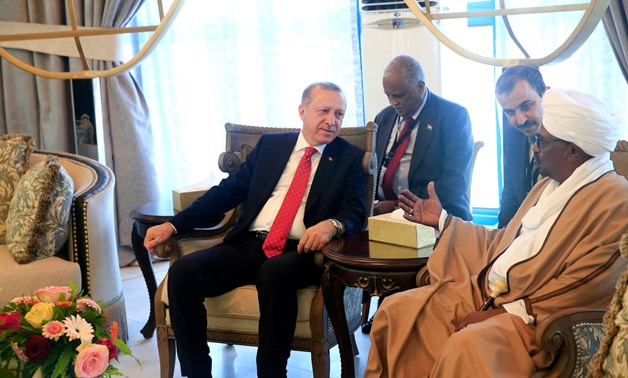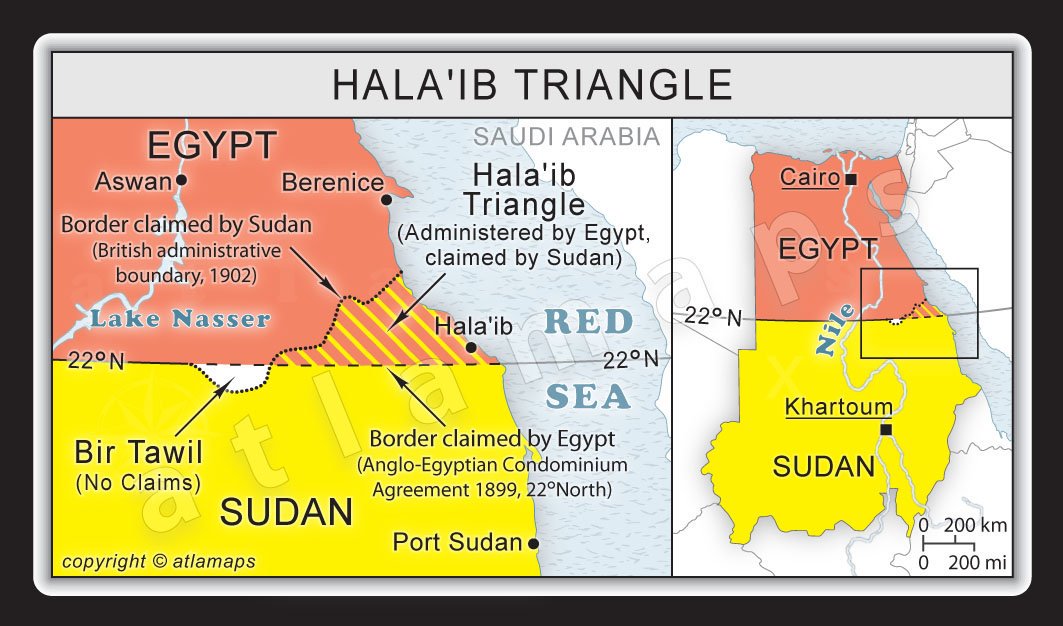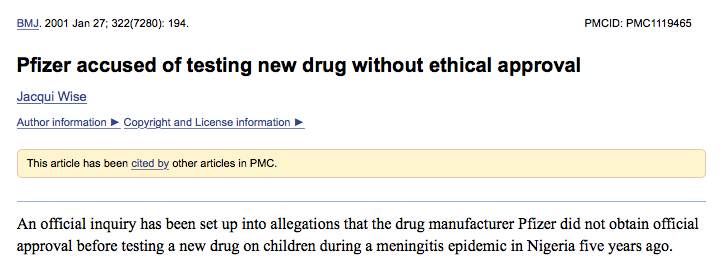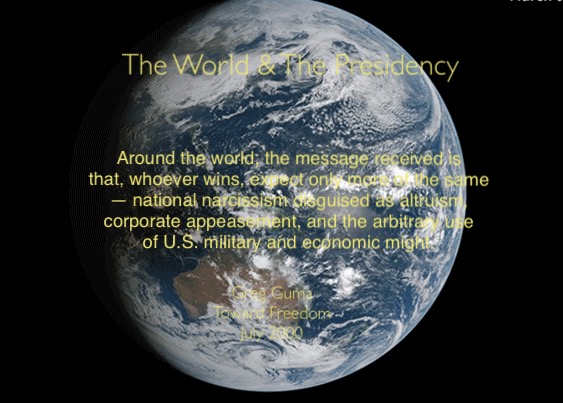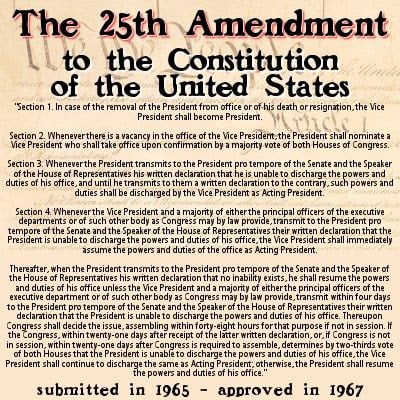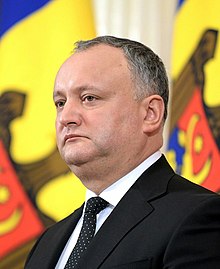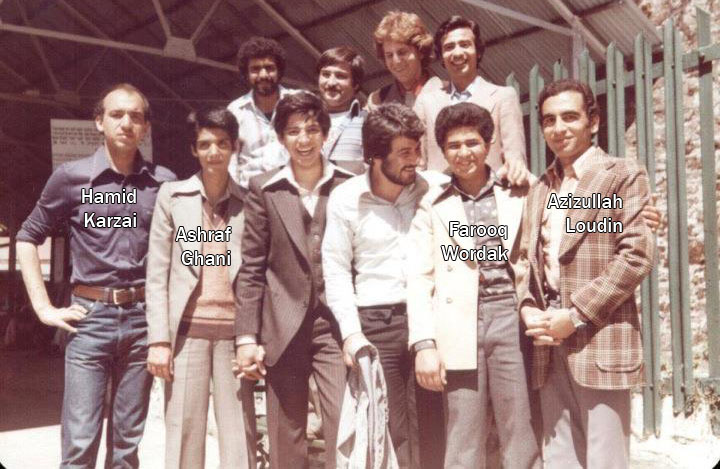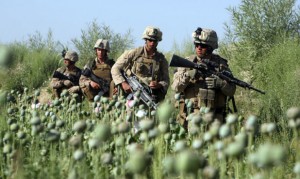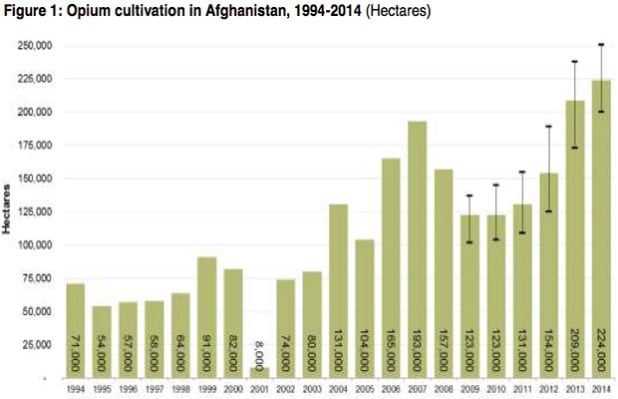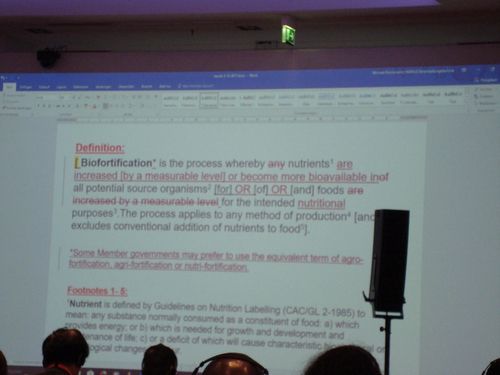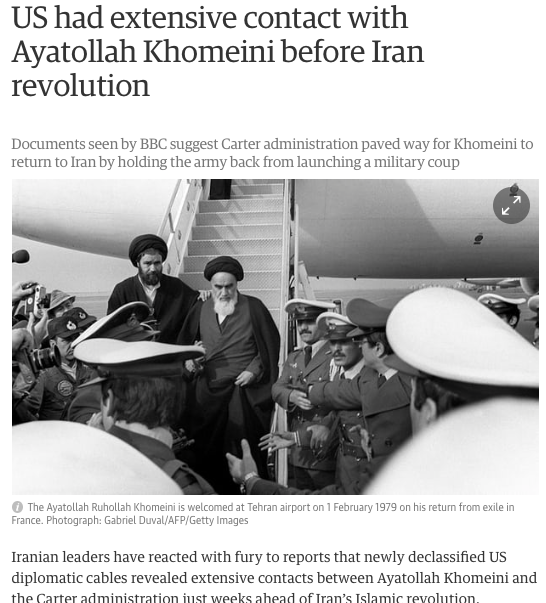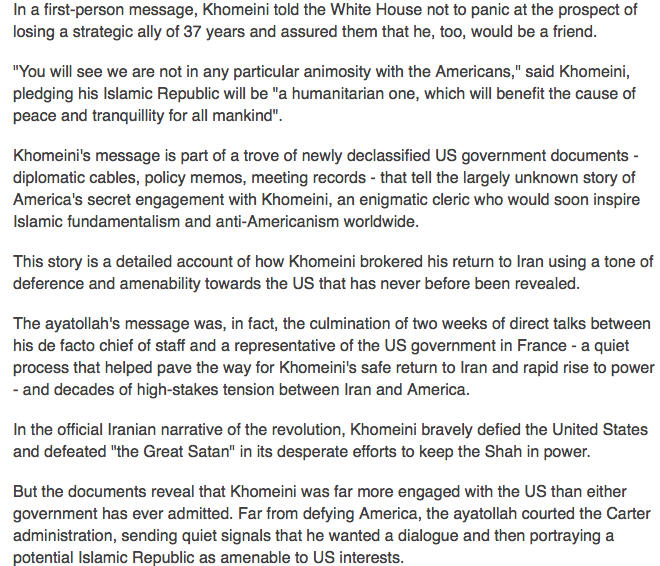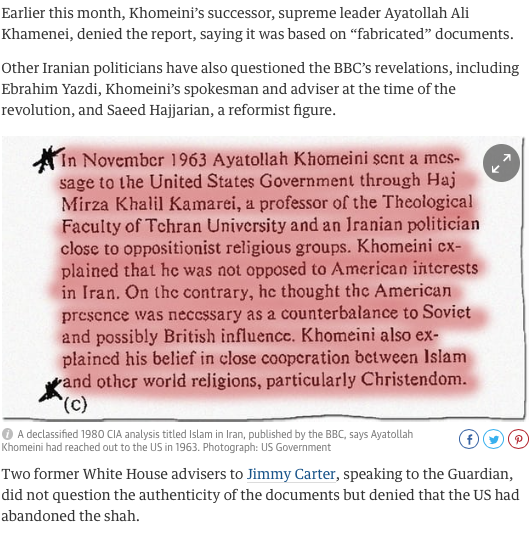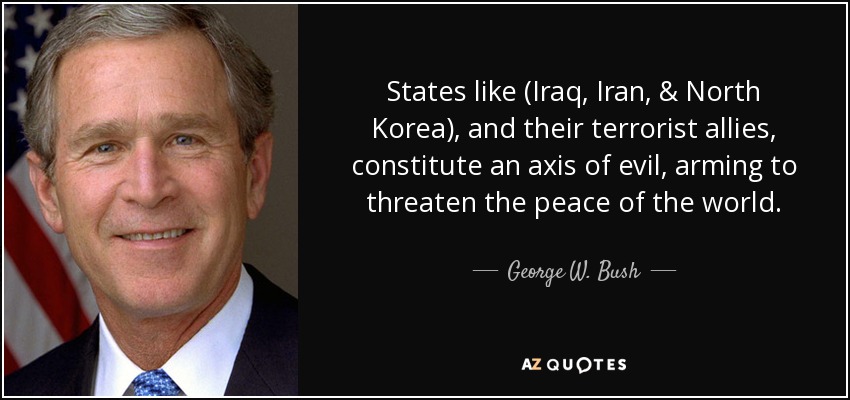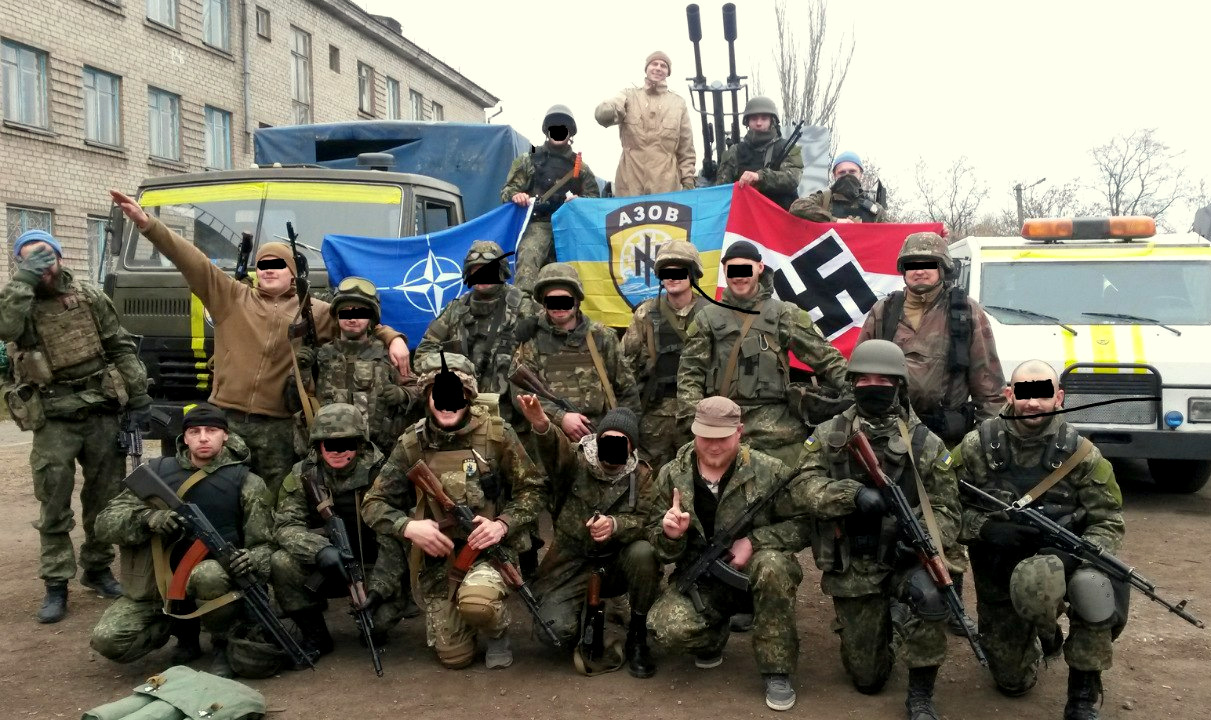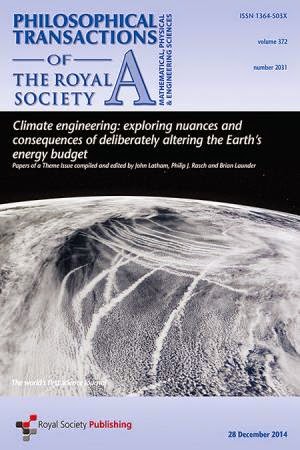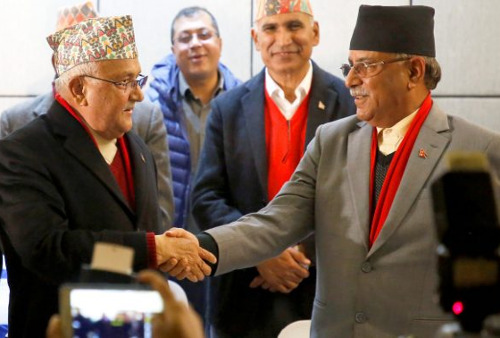Australian Foreign Minister Julie Bishop declared in September 2017 that the emerging US-India-Japan-Australia Indo-Pacific “quadrilateral dialogue” would be founded on “respect for international law and the rules-based order.”1 The reassurance was welcome, but it will mean some big changes, probably on all four sides, most of all for the US, which does not recognize itself as being bound by any rules, remains aloof from the International Criminal Court and commits war crimes including military interventions unauthorized by the UN (therefore acts of aggression), assassination and torture on a daily basis.
As for Japan and Australia, they both appear to rank the US relationship above any principled application of law and to positively embrace the role of “client state” of the violent and lawless United States,2 while India as of 2017 seemed to be following a similar path with its quadrilateral partners.3 In July 2017, it banned all trade with North Korea except for food and medicine, and pledged to support steps to further isolate and pressure the country. These were drastic measures since India was North Korea’s third largest trading partner till 2015-16.4
“North Korea as it is, not as we wish it to be…”5
This paper considers the most recent escalation of the “North Korea crisis,” and the various agendas for addressing it, not just the emergent “Indo-Pacific” quadrilateral but specific Japanese and Australian aspects, the United Nations, Russia and China. North Korea’s nuclear weapon tests – in 2006, 2009, 2013, 2016 (twice) and 2017 (possibly a hydrogen bomb) – and its missile tests, culminating in several of apparently intercontinental range (ICBM) in July and September 2017, defy UN directives, draw condemnation on all sides and expose the consequences of decades of failure to address the structural problems at the heart of the Northeast Asian region. The Indo-Pacific quadrilateral constitutes a significant new framing of the North Korean problem.
Two main sets of proposals now rest on global tables: that by the US and its allies, notably Japan and Australia, demanding North Korean submission as precondition for any negotiation, and the call for freeze and negotiations, such as proposed by China and Russia and supported by other states such as Germany and France and by prominent US figures such as former Defense Secretary William Perry.6
As China’s Foreign Minister put it in May 2017, the latter proposal entails
“that, as a first step, the DPRK suspend its missile and nuclear activities in exchange for a halting of large-scale US-ROK military exercises. This ‘double suspension’ approach can help us break out of the security dilemma and bring the parties back to the table.”7
North Korea for at least the past several decades has sought talks on resolving its highly abnormal situation. What it wants, according to Jimmy Carter, ex-president and presidential envoy who negotiated a way through the crisis of 1994, is a peace treaty with the United States and an end to economic sanctions.8 It also wants to “normalize” relations with Japan and to reach a formal, very belated reckoning with Japan over its colonial record. Its demands are rarely treated seriously. In January 2015 it called on the US to suspend its planned war games in return for which it would abstain at least provisionally from nuclear testing, but Obama’s Washington gave no response.9 A little later, William Perry, who as Secretary of Defense from 1994 to 1997 had brought North Korea and the US close to a negotiated settlement, looked back on almost two decades of failed US policy and urged the US to deal with “North Korea as it is, not as we wish it to be,” to give up for the time being the hope of dismantling its nuclear program (recognizing that it is simply too late) and to concentrate on three No’s: no new weapons, no better weapons, no transfer of nuclear weapons or technology.10 North Korea took note of this widely publicized “Perry process” formula and its state-run media declared a readiness to suspend all further testing if the US would turn to winding up the Korean War (with a peace treaty and “normalization”).11 Instead of pursuing the Perry path, however, the US set about rehearsing “special operations” designed to “decapitate” the North Korean regime (i.e. to capture and/or assassinate its leader, Kim Jong-un).12 The scene was thus set for the crisis of 2017.
Following explicit threats (as in March 2017) that the US had exhausted its “strategic patience,” its “sword stands ready” and “all options are on the table” and there was no room for negotiation,13 the US began to mobilize massive force around the Korean peninsula, with no less than three nuclear aircraft carrier fleets in Asia-Pacific waters,14 multiple destroyers and submarines, backed from time to time by Japan’s mini-aircraft carrier, the 19,500-ton Izumo, and its two Aegis-equipped destroyers, Ashiura and Samidare. US Air Force B-1 bombers, known to inflict especially high levels of fear on Koreans because of their nuclear bomb-carrying role, fly in periodically from Guam and criss-cross the peninsula, escorted by fighters of Japan’s Air Self Defence Force and South Korea’s Air Force. There are roughly 50,000 US troops deployed in US bases in Japan and Korea, and Japan’s Yokosuka is the US 7th Fleet’s home port. March and August are periods of especially high tension, as the US and its allies engage in massive war-rehearsing exercises (Operation Key Resolve in March and Ulchi Freedom Guardian in August), this year (2017) especially ramping up intimidation. These exercises rehearse the invasion and destruction of North Korea.
Yet North Korea refuses to be “compelled.” Simply to “denuclearize” without resolving the problems that led it to “nuclearize” in the first place, would be to present itself naked and defenceless to its enemies. Its goose-stepping soldiers, bizarre mass games and overweight young leader feed into the construction of it as uniquely distorted and “evil.” Its long-continuing existential crisis means that its message to the world is presented in shrill tones that do more to conceal than to communicate its essential legitimacy and reasonableness. As a result, no country in modern history has been so friendless, loathed and contemned. Yet the truly remarkable fact is that North Korea exists at all, having fought the United States and the US–led, UN-authorized, coalition of the willing to a standstill 64 years ago that left the country devastated (with millions dead). Despite unremitting pressure and nuclear threat ever since then, it has refused to submit.
Utterly dwarfed in terms of conventional weapons, and increasingly inferior not only to the United States but also to South Korea (which is about double its size in terms of population and perhaps 10 times greater in terms of GDP), North Korea appears to have concluded that its only plausible defense lies in nuclear weapons and delivery systems. Such a perception can hardly be seen as irrational. North Korea is sometimes described as a “guerrilla state” or “partisan state” (Japanese historian Wada Haruki’s term),15 in reference to the siege mentality cultivated over many decades confronting powerful enemies intent on crushing it, and sometimes as a “porcupine” (prickly, obsessively defensive) state. Its DNA is strong on defense, and has no place for submission to enemies.

Kim Jong-un, Chairman of the Workers Party and Supreme Leader of North Korea, visits the Kumsusan Palace, where the bodies of Kim Il Sung and Kim Jong Il rest, 16 February 2017 (75th birthday of the former North Korean leader Kim Jong Il , The Day of the Shining Star, Kwangmyŏngsŏng-jŏl). (Source: Korean Central News Agency, KCNA)
This is not to say that there are no serious issues of concern over human rights – there obviously are – but to recognize that the conditions under which the state exists – of unresolved war, sanctions, isolation – are such that normalcy cannot be expected, or for that matter demanded, save in the context of a comprehensive resolution.16 Only in the frame of a process of diplomatic “normalization” is North Korea likely to be brought in from the cold of more than 100 years as colony, divided state, and global outsider and its political practice to move or begin to move from dictatorship to democracy.
In 2013-14, the United Nations commissioned the Australian jurist, Michael Kirby, to survey and report on the state of human rights in the country. The ensuing report singled North Korea out as an essentially criminal regime, in which
“systematic, widespread and gross human rights violations have been and are being committed …. In many instances, the violations … constitute crimes against humanity … The gravity, scale, and nature of those violations reveal a state that does not have any parallel in the contemporary world.” 17
This assessment is used to justify sanctions that punish an entire people. The state that had been for almost the entirety of its existence subject to nuclear intimidation18 is designated a threat, rogue regime, and ultimate “other.” Revulsion helps justify genocidal threat, revamped regional alliances and stepped-up militarization, new weapons and missile “defence” systems, and war “games” that rehearse resumption of the Korean War.

Hankyoreh21 Cartoon No.1168, by Kwon Beom-cheol, Hankyoreh cartoonist 26 June 2017
As North Korea conducted its 2017 missile tests, in particular two of apparent ICBMs, President Trump emerged briefly from his New Jersey golf resort to threaten it with “fire and fury, and frankly power the likes of which this world has never seen before.”19 That elicited an equally pugnacious response from the commander of North Korea’s army, General Kim Ryak Gyom, that “sound dialogue is not possible with such a guy bereft of reason”20 and a warning that it was preparing to launch missiles towards the American territory (and major military facilities) of Guam.
In August, the Foreign and Defense Ministers of the US and Japan agreed “to pressure North Korea … to compel [italics added] it to take concrete actions to end its nuclear and ballistic missile program and to achieve the complete, verifiable, and irreversible denuclearization [CVID] of the Korean peninsula.”21 Trump tweeted that the US military was “locked and loaded,” ready for action against North Korea.
Then, on 3 September, came the test explosion of what appeared to be a hydrogen bomb, North Korea’s 6th and by far most powerful nuclear test,22 followed by the 15 September intermediate range ballistic missile, which soared over Northern Japan on a 3,700 kilometre trajectory out into the Pacific . . . demonstrating the capability to reach not only Okinawa but also Guam.
The US position (as denoted by the CVID formula) is that it will only meet North Korea provided it first surrenders. Japan’s Prime Minister Abe made this same point in his “op-ed” contribution to the New York Times in September 2017,23 and Australian Foreign Minister Bishop has said the same on multiple occasions.
But nobody who has ever studied North Korea or its history believes that it will submit to pressure or intimidation, or abandon its nuclear and missile programs short of a comprehensive settlement of its security concerns. So the US demands the impossible, and the mobilization of massive forces just offshore to back it up can only be seen as part of a dual design: to induce submission or to provoke North Korea to take some action that would justify mass “retaliation.”
As Trump continued to contemplate the option of war, in August he told Republican Congressman Lindsey Graham that there would indeed be many deaths, but
“they’re going to die over there, they’re not going to die here.”24
On 19 September, he addressed the United Nations General Assembly (in a speech for which it is hard to think of any match in terms of its ferocity), deriding Kim Jong-un by referring to him as “rocket man . . . on a suicide mission,” threatening that North Korea stood to be “wiped out,” and the US would be “forced to totally destroy” it unless it submitted.25 Days later, Kim Jong-un responded in person that
“I will surely and definitively tame the mentally deranged US dotard with fire,” making Trump “pay dearly” for his speech threatening North Korea’s “total destruction.”
North Korean Foreign Minister Ri Yong-ho added days later before the UN General Assembly that Trump was the one “on a suicide mission,” whose “insult to the supreme dignity” of North Korea had made “inevitable” a rocket’s “visit to the US mainland.”
The stance of the US and its allies in threatening, denouncing, and refusing to negotiate is patently illegal and criminal. The clauses from the Charter cited above are unambiguous and, according to the World Court (the ICJ) in its Advisory Opinion (1996) on the Threat or Use of Nuclear Weapons, the legality of a threat stands or falls on the same legal grounds as if the threat were carried out.”26 US threats over many decades culminating in Trump’s to “destroy” or “annihilate” North Korea constitute crimes under both the Charter and the 1948 Geneva Convention to which the United States is a party.27
While the quadrilateral to which Australian Minister Bishop referred unite in condemning and punishing North Korea for its nuclear and missile tests, they turn a collective blind eye to India’s development of a weapons program outside the confines of the Non Proliferation regime (NPT) – current estimates put its nuclear arsenal at well over one hundred nuclear weapons – and, of course, to the thousands of tests conducted by the US. Neither Australia nor Japan take serious exception to this. Both tacitly encourage India, the one by providing it with a nuclear power generating plant and the other with uranium. No other country has been subject to anything comparable to North Korea’s 67 years’ exposure to threat of nuclear extermination coupled with economic and political pressures including sustained blockade. Consequently, the one country in today’s world that might have claim to justification for the “threat or use of nuclear weapons” under the ICJ’s 1996 “Advisory Opinion,” on grounds of an “extreme circumstance of self-defence, in which the very survival of a State would be at stake,” would have to be North Korea.28 It may be mistaken, but not necessarily unlawful, while the unlawfulness of all the other nuclear weapon countries, ignoring their obligation under Article 6 of the Non Proliferation Treaty to set about denuclearizing, is plain.29 Bizarrely, the one country that could plead legal justification for possessing nuclear weapons is the one whose possession much of the world unites to denounce.30
US Clients – Japan and Australia
Where much of the world recoiled in horror from such mutual brinksmanship, the Abe and Turnbull governments associated themselves unconditionally with it, encouraging Trump in his obduracy while India moved decisively to align itself with them. Nobody in the Japanese, Australian or Indian governments is on record as protesting against the US threats. Prime Minister Abe had in April 2017 showed strong support for the cruise missiles Trump launched against Syrian targets and made clear his approval for the American threat to North Korea that “all options” were on the table.31 His then Defence Minister, Inada Tomomi, reiterated that position. “All options” obviously included war and nuclear weapons. Japanese SDF vessels and planes participated in war rehearsal exercises, escorting US aircraft carriers and B-1 bombers on their missions designed to intimidate and terrorize, i.e. rehearsing attack on North Korea.
There was understandable sense of resentment at the North Korean missiles in 2017 passing “over” Japanese territory, but since they passed “over” Japan at a height of somewhere between 500 and 800 kilometres, well above the so-called Karman Line (at 100 kilometres) that defines the beginning of “Outer Space,” and since outer space is “not subject to claims of national sovereignty,” Japan had no standing to protest.32 Nevertheless, the government spent considerable sums on advertisements designed to feed fear of North Korea.33 Japanese railway companies, including the Tokyo subway system, suspended their service, cities and towns conducted public drills, and children learned to crawl under their desks in readiness for possible nuclear attack. TV programs were interrupted with “J-Alert” messages announcing launch of missiles. The nuclear shelter construction industry thrives.34 The North Korean “threat” helps Abe justify stepped up military spending (roughly $46 billion in the latest budget), militarization of the frontier islands (Ishigaki, Miyako, and Yonaguni), and the construction of facilities for the US Marine Corps in Northern Okinawa and in Guam and the Marianas. It also helps prepare the ground for revision of the constitution (Abe’s lifelong ambition). Deputy Prime Minister Aso Taro was not alone in attributing Abe’s substantial electoral victory of October 2017 to the North Korean threat.35
Despite the aggressive tone of Japanese government comment, and the deep-seated ill-will on both sides, it is just fifteen years since the “Pyongyang Declaration” issued by the Japanese and North Korean leaders on the occasion of Prime Minister Koizumi Junichiro’s visit to Pyongyang in September 2002. Then, the two countries came close to a historic settlement.36 Japan apologized in a spirit of “humility,” expressing “deep remorse and heartfelt apology” for the “tremendous damage and suffering to the people of Korea through its colonial rule in the past,” and North Korea’s Kim Jong-il apologized for the abduction of Japanese citizens [in 1977-1983] and promised “appropriate measures so that these regrettable incidents, that took place under the abnormal bilateral relationship, would never happen in the future.”37
Since then, however, the question of abduction of Japanese citizens has defied resolution and preoccupied Japanese attention. North Korea in 2004 returned those it said were the surviving victims, only to have Japan respond by declaring that abduction was the single most important issue (ranking above nuclear weapons or missiles) and that there could be no normalization of relations until all abductees were returned, “all” including those who North Korea said were no longer living. Following a Japan-DPRK agreement in Stockholm in May 2014, North Korea again undertook to investigate, but when it reported once again that there were no survivors the process collapsed. During 2017, President Trump also adopted the Abe cause of the abductees, referring to it both in his UN speech and in his Tokyo speech in November. Yet the only way forward on resolving the hostage issues, as specialists suggest, is likely to be for Japan first to recognize and normalize diplomatic relations with North Korea and then to conduct its own investigation from its embassy in Pyongyang. The US initiative under President Obama in 2016 in opening diplomatic relations with Cuba is cited as an example that Japan might choose to follow.38

UN Security Council, Voting Sanctions on North Korea, September 2017
As for Australia, Prime Minister Malcolm Turnbull declared on radio that “In terms of defence we are joined at the hip” and it would promptly join if needed for any resumption of the Korean War. 39 He later added, as if seeking approval in Washington and Tokyo, reference to the government of North Korea as “a criminal organization operating under the guise of a state.”40 Even after the adoption of the September package of sanctions and the abusive Trump UN speech, Foreign Minister Julie Bishop opined, that “I believe there is more we can do in exerting political, diplomatic and economic pressure on North Korea.”41 She favoured “autonomous sanctions” that went beyond the UN-ordered ones.42 An example soon arose. Australia refused visas to an under-19 North Korean soccer team to compete in the Asian Football Federation championships.
“Hosting the team,” said Foreign Minister Bishop, “would be contrary to the government’s strong opposition to North Korea’s illegal nuclear and missile development programs.”43
It was precisely the sort of collective punishment principle against which, rightly, Australia might take exception when practiced by North Korea. No politician or public figure in Australia had any word to say on behalf of the North Korean under-19s.
Contrary to popular understanding, responsibility for the breakdown of past negotiated agreements has been far from one-sided.44 The introduction of nuclear weapons to the peninsula in the first place, the refusal to take seriously obligations under the Non-Proliferation Treaty to “negotiate in good faith to achieve a precise result – nuclear disarmament in all its aspects – and the inclusion of North Korea on the nuclear target list were all breaches of the Non-Proliferation Treaty.
For its part, from time to time North Korea has engaged in negotiations in which it showed readiness for negotiated solutions, periodically suspending and promising to negotiate away its nuclear weapons and programs, notably between 1994 and 2002 under the so-called “Agreed Framework” and again in 2005-6 under the Beijing Six-Party conference agreement, and again in 2007 at the time of major negotiations between North Korea and the United States in Berlin and Beijing. It was the US then that was described, by Jack Pritchard (formerly the State Department’s top North Korea expert) as “a minority of one … isolated from the mainstream of its four allies and friends”45
Strongly backed, or urged on, by Japan, the US was able to sink the agreements hammered out around the various tables and ensure that nothing short of surrender and submission on North Korea’s part would suffice.46 C. Kenneth Quinones, a former State Department official with considerable experience of negotiating with North Korea, said that he had been able on no less than three occasions in 2005 to find a basis for agreement between the North Korean and US governments, only to have his efforts sabotaged by the Bush/Cheney/Rumsfeld leadership. He referred to North Korea as being “very precise and consistent in their positions” while by contrast the track record of the then Bush administration was “not one of diplomacy but rather one of vacillation, inconsistency and, ultimately, undercutting the position and the efforts of its own diplomats.”47 South Korea’s chief negotiator at the Six Party talks in 2006 and 2007, Chun Young-woo, spoke of his sense that the North Korean participants at those talks felt “besieged, squeezed, strangled, and cornered by hostile powers” and noted the tone of “visceral aversion” or “condescension, self-righteousness or a vindictive approach” on the part of the major parties (by which he plainly meant first and foremost, the United States).48 Jeong Se-hyun, Unification Minister in South Korea between 2001 and 2004, has also written recently of the “mistaken” impression that North Korea never honours its international agreements, saying (in respect of the Beijing “Six Party” negotiations of 2003-8) that the United States also bears responsibility.49
The UN
According to the UN Charter’s Article 2 (3), disputes between states must be settled by peaceful means and (4) “All members shall refrain in their international relations from the threat or use of force against the territorial integrity or political independence of any state …” [italics added]. Article 33 further specifies the obligation of parties to any dispute likely to endanger international peace and security to “first of all, seek a solution by negotiation inquiry, mediation, conciliation … or other peaceful means of their own choice.” By ruling out negotiations with North Korea and insisting only on submission, the US, Japan and Australia ignore or breach this clear rule (and Japan breaches also the proscription on the “threat or use of force as means of settling international disputes” in its own constitution). Going beyond that, President Trump has also not only insulted the North Korean leader from the platform of the UN General Assembly but actually threatened his country with “total destruction,” by “fire and fury, and frankly power the likes of which this world has never seen before.”50 That surely qualifies as threat. It is even genocidal, and therefore criminal behaviour, not only on the part of those (Trump) who utter it but on the part also of those like Abe and Turnbull (to whom perhaps now India’s Modi is to be added) who endorse and encourage it.
The United States and Japan have also played key roles in steering through the UN Security Council the series of sanctions culminating in the eighth set (under Resolution 2371 of 6 August 2017) which forbade, inter alia, the export of coal, iron, iron ore, lead, lead ore and seafood, and the ninth (under Resolution 2375 of 11 September) which banned North Korean textile exports, froze or capped crude oil and refined petroleum imports and banned new labour export contracts.51
The impact of these measures, affecting the country’s major exports, imports, and foreign currency earners, would – or should – be expected to bring the country to its knees. It is possible they may not actually work that way as, at least until 2017, despite the then already severe sanctions, visitors reported North Korea to be bustling and even, astonishingly, thriving,52 suggesting that, having lived with sanctions for more than half a century, it has cultivated a will to survive that is stronger than that of its enemies to have it collapse, but the intent is plain – to cause collapse and/or surrender – and that intent is criminal. From 2017, as the country suffers both partial failure of the 2017 harvest (due to severe drought), 53 and the unprecedentedly severe sanctions prescribed by Resolutions 2371 and 2375, it may not “thrive” much longer. Even so, however, the likelihood is that stepped up pressure will be counter-productive, reinforcing the regime’s determination not to surrender even if, as Vladimir Putin put it, it means the people having to eat grass.54 The indiscriminate and plainly hostile steps mandated by the Security Council, reinforced by the autonomous measures and all supported by the US, Japan, Australia, and India, are not only illegal but help the regime rally internal support and crush dissent.
Beyond the already comprehensive sanctions, hostile governments, notably the US, Australia and Japan, work to cut North Korea off completely from international trade or banking, urging countries around the world “to cut trade links with Pyongyang to increase North Korea’s financial isolation and choke off revenue sources.”55 Only a very fine line divides such measures from outright war. Neither side would appreciate the analogy but today’s North Korea in its isolation, desperation and determination to unite around its leader resembles no country so much as Japan in 1941. Knowing that Japan then chose Pearl Harbour rather than submission, the analogy is not reassuring.
As exports are slashed and energy imports squeezed, it will be the ordinary and under-privileged rather than North Korea’s power elites who will suffer. It amounts to collective punishment. That too is strictly forbidden in international law. Only sanctions carefully tailored to apply to those who act in the name of the government and bear responsibility for its offensive actions may be legitimate. There is some dispute over the number of victims, including children, from the sanctions applied by the UN to Iraq from 1990, but US ambassador to the UN, Madeleine Albright was unapologetic years later saying that, although it was a “hard choice,” the price, even if it included deaths of half a million children “was worth it.” The point is clear that that those imposing sanctions bear an obligation to ensure they impact only upon those who are in a position of power, not on innocent civilians. Despite the UN’s targeting of an entire people in North Korea for punishment, opposition is scarcely to be heard. The equation of North Korea with “evil” has turned the country into the ultimate “other.” There is reason to wonder if the United Nations itself, by the ordering of collective punishment of the entire North Korean people for offenses committed by their government, may be acting criminally.
Hayes and von Hippel comment:
“The immediate, primary impacts will be on welfare: people will be forced to walk or not move at all, and to push buses rather instead of riding in them. There will be less light in households due to less kerosene, and less on-site power generation. There will be more deforestation to produce biomass and charcoal used in gasifiers to run trucks, leading to more erosion, floods, less food crops, and more famine, There will be less diesel fuel to pump water to irrigate rice paddies, to process food into foodstuffs, and to transport agricultural products to markets before they spoil.”56
Furthermore, the UN as an organization bears a peculiar responsibility, rarely remembered, for the “Korean problem,” first by its dividing the country in 1947, and then by war from 1950, when it intervened against its own charter in the Korean civil war and when multiple, still unassuaged, war crimes were committed. Whoever started the war, it was the forces of the United Nations that devastated the country, and an overwhelming proportion of casualties were civilian. The northern side, whatever its moral qualities or the justice or otherwise of its cause, simply did not have the capacity to mete out comparable indiscriminate death to the civilian population by bombing, strafing, napalming, blasting dams or destroying food crops57 The most horrendous incidents of massacre, at places such as Taejeon and Nogunri, then blamed on the “communists,” were revealed much later to have been committed by “our” side. In the most shocking incident, later known as the Taejeon Massacre, between 5,000 and 7,500 civilians were slaughtered in what the US Army described as an event “worthy of being recorded in the annals of history along with the Rape of Nanking, the Warsaw Ghetto, and other similar mass exterminations.” Circulated and given widespread publicity around the world in I953 and later, this horror story helped fix the image of North Koreans as brutal savages. We now know, however, as I wrote in 1983, that this worst atrocity of the war was committed by forces acting in the name of the United Nations.58
Much more detail has been revealed about it by the South Korean government’s Truth and Reconciliation Commission.59 Overall, that Commission, following intensive investigations in the period between 2005 and 2010, confirmed that in the first year of the war alone about 100,000 people were massacred by US, South Korean (and other) forces under the UN flag.60
In 2017, following a seven year hiatus in its work under right-wing governments, researchers have resumed their work and concluded that “around 1 million civilians were killed by the government-led massacres during the [Korean] war.”61 “Government-led,” when referring to the Korean War that began on 25 June 1950, means under the aegis of the United Nations (with not only the United States but also Australia in a prominent role). For UN intervention today to have moral credibility, its responsibility for such war crimes and for almost seven decades-long neglect of (and therefore continuing complicity) in US nuclear intimidation, should be faced. It is an uncomfortable thought that the global community itself, through the UN, even while taking a self-righteous stance towards North Korea, might have been guilty of successive war crimes against it.
Putin, Moon, and the Eurasian Project
Currently “on the table” in regard to the “North Korea problem,” are two contrasting proposals: the US-Japan-Australia (perhaps joined by India) demand for unconditional North Korean submission and the Russian-Chinese proposal (for the most part shared by South Korea), condemning the North Korean missile and nuclear tests but urging “three Nos” to freeze the existing status quo, taking steps to defuse tensions, respect the DPRK’s “justified concerns” and create a peninsular “peace and security mechanism.”62 The former has no vision for the region other than to shore up US hegemony but the latter does, and it is a bold and ambitious one.

South Korean President Moon and Russian President Putin, Vladivostok, September 2017
In a remarkable 6-7 September 2017 meeting that passed almost unnoticed in the Western and Japanese media,63 the two Koreas (South and North), Japan, Russia and China met at Vladivostok under the auspices of the Eastern Economic Forum (EEF), a relatively new (established in 2015) Russian initiative to promote the development of its Eastern zone. The five states (absent only the United States) of the Beijing Six Party Conference proceeded in low key, consensual mode, to endorse (or in the case of North Korea at least “not oppose”) what has been called the Putin plan.64 It dealt essentially with economic cooperation, railways and pipelines, but its implications are far from mundane.65
The Vladivostok parties looked to open multiple lines of cooperation and communication across North Korea, extending Siberian oil and gas pipelines to the two Koreas and Japan and opening railways and ports linking them across Siberia to China, the Middle East, South Asia, and Europe. South Korea’s President Moon projected his understanding of this within the frame of what he called “Northeast Asia-plus,” which involved construction of “nine bridges of cooperation” (gas, railroads, ports, electricity, a northern sea route, shipbuilding, jobs, agriculture, and fisheries),66 embedding the Korean peninsula in the frame of the Russian and Chinese-led BRICS, the Belt and Road Initiative (BRI) and Shanghai Cooperation Organiziation (SCO) organizations, extending and consolidating those vast, China- and Russia-centred geo-political and economic groupings.
Though billed as “economic,” and having no explicit “security” element, the Vladivostok conference was nevertheless one that would go a long way towards meeting North Korea’s security concerns and making redundant its nuclear and missile programs. Under it, the Beijing Six Party Talks formula of 2003-8 would become “Five Plus One,” with the United States reduced to non-participant “observer.” Unstated, but plainly crucial, North Korea would accept the security guarantee of the five (Japan included), refrain from any further nuclear or missile testing, shelve (“freeze”) its existing programs and gain its longed for “normalization” in the form of incorporation in regional groupings, the lifting of sanctions and normalized relations with its neighbour states, without surrender.
Perhaps the most remarkable feature of this Vladivostok agenda is the participation of the Japanese Prime Minister Abe and his Foreign Minister Kono Taro. The Abe government had till then matched Trump in uncompromising hostility to North Korea, and had just weeks earlier formally agreed with the US that CVID, North Korean submission, was the only way forward. Yet they appear to have responded positively to the Putin plan, which suggested that a diplomatic “Plan B” might be under active consideration in Tokyo, and that Vladivostok might mark a first step towards a comprehensive, long overdue, post-Cold War re-think of regional relationships.
The Moon-Putin Plan held the potential not only for resolving the North Korea problem, sidelining the US, but also for transforming Japan-Russia and Japan-China relations. It could be expected to lead in due course to diplomatic recognition and a resolution of the complaints of the parties, completing the Japan-North Korean reconciliation process that was begun but then suspended under Prime Minister Koizumi (in 2002).
The challenge was greatest for Japan, calling for it to re-negotiate its relationship with the US away from clientelism towards an equal, friendly bilateral relationship, gradually liquidating US military bases and having East China Sea neighbour countries construct their relationships afresh, independently, North (and South) Korea would become points of Japanese engagement with the burgeoning regional development groupings, steps in the path of regional cooperation and community building. It was an unlikely agenda for a Prime Minister as apparently dedicated to Japan’s role as US “client state” as Abe, but Japanese reports suggest that Abe was seriously considering taking an initiative (reversing his stance to date) along the lines of this Putin or Moon-Putin plan),67 but that US pressure was being brought to bear to put the kibosh on any such radical shift.68
It is a measure of how the world has changed that it should have been left to the Russian and Chinese presidents and Foreign Ministers to articulate moderation, reason, and law, calling for negotiation without pre-conditions, insisting on North Korea’s right to survive, and making a comprehensive (if still lacking in specificity) proposal for integrating North Korea into a community with its neighbours. Russian president Putin, even while accepting the US and Japanese demand for ever stricter sanctions, nevertheless insisted that ramping up pressure by itself was futile and dialogue without pre-conditions the way forward.69
“Do you really think that because of the imposition of some sanctions, North Korea will abandon its course towards development of weapons of mass destruction? Under these circumstances, winding up military hysteria will not bring us any good. All of this can lead to a global catastrophe on the planet and huge numbers of human casualties. There is no other way apart from a peaceful and a diplomatic one to resolve the North Korea nuclear problem.”
Germany’s Merkel and France’s Macron share this basic approach and oppose the hard-line US-Japan-Australia coercion formula.70 UN Secretary-General Antonio Guterres too warns that “fiery talk can lead to fatal misunderstandings … the solution must be political — this is a time for statesmanship — we must not sleepwalk our way into war.”71
The ultimate prospect of a trans-Pacific regional peace and cooperation community to replace the “hub and spokes” US-hegemonic, San Francisco Treaty system would, needless to say, have momentous implications.
Russia-Japan
As for the Japan-Russia relationship, the territorial dispute over the “Northern islands” (the Southern Kuriles) between Russia’s Kamchatka Peninsula and Japan’s Hokkaido, seized by the then Soviet Union in the final month of World War II) remains unresolved. However, Prime Minister Abe has met more than a dozen times with Putin in the five years of his second term and the two have established a certain rapport. When he hosted a Putin visit in December 2016 to his home prefecture of Yamaguchi, speculation was rife that they might strike an agreement for the return, or partial return, to Japan of the islands. It did not happen but the prospect may have become a little less far-fetched.
Reversion to Japan of the two smaller island groups (7 per cent by area of the territory as a whole), Habomai and Shikotan, had been agreed in principle in 1956, only to have Japan withdraw under pressure from a United States fearful that reconciliation between Japan and the Soviet Union might lead to Japan slipping out of the bi-polar Cold War system into neutralism. The disposition of the two larger islands, Kunashiri (Kunashir) and Etorofu (Iturup), however, presents greater difficulty. These are very large islands indeed, Etorofu even two and a half-times larger than Okinawa Island at the country’s other extremity. A transfer of sovereignty after nearly 70 years would not be easy, but with a positive disposition on both sides an acceptable formula should be conceivable, with a suitable face-saving formula, perhaps postponing their legal disposition to an indeterminate future while focussing in the interim on cooperative development and conservation.
Discussions between the two countries are by no means confined to territory and islands. The two have drawn up their lists, whittled down by 2016 to thirty “priority projects” ranging widely across the development of Eastern Siberia and Northern Russia, especially resources (oil and gas), but also infrastructural projects (pipelines, railroads and ports). There is bound to be some correspondence between the multilateral “Vladivostok” agenda discussed above and the projects on the table in bilateral Russo-Japanese negotiations. Both look to a grand transformation. At their most ambitious, the bilateral Russo-Japanese plans include a railway crossing by tunnel under the Soya [La Perouse] Strait between Hokkaido and Sakhalin and a bridge across the Mamiya [Tartar] Strait between Sakhalin and Siberia (just 7.3 kilometres at its narrowest point), establishing a through rail link from Japan via the Trans-Siberian and Baikal-Amur railway system to China, Russia, and beyond.72
Normalizing relations with either or both of North Korea and Russia would undoubtedly be difficult for Japan to explain to Washington, but it would go a long way towards recasting the region’s diplomatic and security frame and a Japan that could contemplate doing either would no longer be a client state. The Vladivostok conference showed that such mammoth schemes, hitherto little more than pipe dreams, were back on drawing boards in Moscow and Tokyo as well as Beijing, Seoul, and Pyongyang. On all sides the agenda of bridges and tunnels of communication replacing confrontation and military build-up and linking Japan and Korea with the Eurasian continent is “on the table.” It is certainly a more attractive prospect than what is on the Trump-Abe-Turnbull table.
*
Gavan McCormack is emeritus professor of the Australian National University and an editor of The Asia-Pacific Journal. His works on Korea include Cold War Hot War: An Australian Perspective on the Korean War, (Sydney, Hale and Iremonger, 1983), and Target North Korea: Pushing North Korea to the Brink of Nuclear Catastrophe, (New York, Nation Books, and Sydney, Random House Australia, 2004).
Notes
1David Wroe, “Australia weighs closer regional four-way ties,” Sydney Morning Herald, 1 September 2017.
3The four met at the ASEAN summit in Manila on 12 November 2017, “as a first step towards deeper cooperation to baance Chinas strategic expansion.” (David Wroe, “Safety in numbers as forur-way security meeting hedges China,” Sydney Morning Herald, 14 November 2017.
4Samuel Ramani, “India’s u-turn on North Korea policy,” The Diplomat, 19 July 2017. (According to Ramani, Indian motives may include the hope that “cooperation with the United States against the DPRK could cause Washington to reciprocate with a harsher stance towards Pakistan.”)
5William J. Perry (Secretary of Defense, 1994-1997), “How to contain North Korea,” Politico, January 10, 2016
6Perry, op. cit.
7Chinese Foreign Minister Wang Yi, Quoted in Fu Ying, “The Korean nuclear issue: past, present, and future – A Chinese perspective,” John L. Thornton China Center at Brookings, Strategy Paper 3, May 2017, pp. 1-24, at p. 23.
9Wada Haruki, “Kita chosen kiki to heiwa kokka Nihon no heiwa gaiko,” Sekai, July 2017, pp. 96-104, at p. 99.
10Perry, op. cit.
11Wada, p. 99.
12On Oplan 5015, the “decapitation strike,” see Choe Sang-hun,”“North Korean hackers stole US – South Korean military plans, lawmaker says,” New York Times, 10 October 2017.
14Franz-Stefan Gady, “3 US carrier groups enter Asia-Pacific ahead of Trump’s visit,” The Diplomat, 25 October 2017.
15Wada Haruki, Kin Nissei to Manshu konichi senso, Tokyo, Heibonsha, 1992.
16See Gavan McCormack, Target North Korea: Pushing North Korea to the Brink of Nuclear Catastrophe, New York, Nation Books, 2004, especially chapters 3 and 4.
17For my discussion of the Kirby report, “Human rights and humanitarian intervention: the North Korea case,” Seoul, Journal of Political Criticism, vol. 16, No 5, 2015, pp. 151-171.
19Peter Baker and Choe Sang-hun, “Trump threatens ‘fire and fury’ against North Korea if it threatens US,” New York Times, 8 August 2017
20“North Korean military says Trump is ‘bereft of reason’,” CBS News, 9 August 2017.
22It may ave reached 250 kilotons, almost 17 times greater than the Hiroshima weapon. (Michele Ye Hee Lee, “North Korea’s latest nuclear test was so powerful it reshaped the mountain above it,” Washington Post, 14 September 2017.
23“Shinzo Abe: Solidarity against the North Korean threat,” New York Times, 17 September 2017.
25Jesse Johnson, “Trump threatens total destruction of North Korea,” Japan Times, 20 September 2017.
27Francis Boyle (University of Illinois) quoted in “Washington’s ‘game of chicken’ with North Korea could have catastrophic consequences,” Sputnik, 19 September 2017, ibid.
28International Court of Justice, op. cit.
29The International Court of Justice unanimously interpreted Article VI of the Non-Proliferation Treaty as implying an obligation on the part of nuclear weapon states to “pursue in good faith and bring to a conclusion negotiations leading to nuclear disarmament in all its aspects under strict and effective international control.”
30Broinowski suggests North Korea might even have a case under Article 51 of the UN Charter which maintains the right to self-defence when a sovereign state is under direct attack by a foreign power (Adam Broinowski, “Picking up the pieces amid the US-North Korea nuclear standoff,” Pearls and Irritations, 25 August 2017)
31Wada, op. cit. Lee Jin-man, “The many North Korean policies of the Trump administration,” The Atlantic Monthly, April 2017.
32See the entry for “Outer space,” Wikipedia, and sources cited there.
33Ide Hiroyuki, “’Kyofushin surikomi’ ni hihan dai,” Shukan kinyobi, 7 July 2017, p. 5.
34Michael Penn, “North Korea’s threat boosts bomb shelter sales in Japan,” Al Jazeera, 28 June 2017.
35Aso made, and then withdrew, this comment. See Kyodo, “Test-happy Pyongyang accuses Abe of ‘hysteric’ campaigning to win election,” Japan Times, 26 October 2017
38Wada, op. cit.
40Lindsay Murdoch, “PM ramps up thetoric calling N Korea ‘cunning rriminals.” Sydney Morning Herald, 13 November 2017
41David Wroe,“Bishop vows further sanction pressure against N Korea,” Sydney Morning Herald, 20 September 2017
42Julie Bishop, “Failure to check North Korea could embolden ohers to pursue deadly weapons,” Sydney Morning Herald, 12 October 2017.
43Tom Minear,”North Korea’s under-19 soccer team blocked from entering Australia,” Herald-Sun, 10 October 2017
44Tim Shorrock, “Diplomacy with North Korea has worked, and can work again,” The Nation, 5 September 2017.
45Charles L. (Jack) Pritchard, “Six Party Talks Update: False Start or a Case for Optimism,” Conference on “The Changing Korean Peninsula and the Future of East Asia,” sponsored by the Brookings Institution and Joongang Ilbo, 1 December 2005.
46See my Target North Korea: Pushing North Korea to the Brink of Nuclear Catastrophe, New York, Nation Books, 2004; also “Difficult Neighbors — Japan and North Korea,” in Gi-Wook Shin, Soon-won Park, and Daqing Yang, eds, Rethinking Historical Injustice and Reconciliation in Northeast Asia, London and New York, Routledge, 2007, pp. 154-172.
48Chun Young-woo, “The North Korean nuclear issue,” speech to Hankyoreh Foundation conference, Busan, 25 November 2006.
50Peter Baker and Choe Sang-hun, “Trump threatens ‘fire and fury’ against North Korea if it threatens US,” New York Times, 8 August 2017
53The failure of the summer rains in 2017 had already caused the country to be “unable to properly feed its people, including soldiers…” (Justin McCurry, “Drought and now sanctions add to North Korea’s hardships,” Guardian Weekly, 1 September 2017)
54Justin McCurry and Tom Philips, “Putin calls for dialogue to avert a catastrophe,” Guardian Weekly, 8 September 2017.
55Acting Assistant Secretary of State Susan Thornton. Countries that have bowed to such pressure include India, Philippines, Mexico, Peru, Egypt, and Uganda (Gregory Elich, “Trump’s war on the North Korean people,” Counterpunch, 19 September 2017.)
57See my discussion in Stewart Lone and Gavan McCormack, Korea since 1850, New York, St Martin’s Press, 1993, especially pp. 120-122. And for pages of this book on Taejeon, see here.
58Ibid, pp. 120-122
60Gregory Henderson, then a US embassy official, gave this figure in his 1968 work, Korea – The Politics of the Vortex, Cambridge, Mass, 1968, p. 167.
63For two exceptions, Pepe Escobar, “Mr Trump, Tear down this (Korean) wall,” Asia Times, 16 September 2017, and Tanaka Sakai, “Puchin ga Kita chosen mondai o kaiketsu suru,” Tanakanews online, 20 September 2017.
64Putin was host of the meeting, but in a sense the proposal might better be referred to as “Putin-Moon” because of the significant South Korean input.
67Well-known Japanese public intellectual and media figure Tahara Soichiro reports having been summoned for discussion by Abe, whereupon he outlined a regional plan along the lines suggested here, drawing an enthusiastic response from the Prime Minister. (Tahara Soichiro, in Shukan Asahi, 22 September 2017, as noted in Jinbo, op. cit., at p. 72.)
68According to sources noted by Jinbo Taro, “Media hihyo” (119), Sekai, November 2017, pp. 65-72.
70“Kita Chosen – atsuryoku ippendo wa Nichibei dake,” Tokyo shimbun, 12 October 2017.
72At 43 kilometers long and up to 70 meters deep, the Soya Strait would be an expensive project but probably no more technically difficult than the existing Japanese Seikan tunnel under the Tsugaru Strait between Honshu and Hokkaido (53 kilometers long and 140 meters deep). Kiriyama Yuichi, “Shiberia tetsudo no Hokkaido enshin, Roshia ga keizai kyoryoku de yobo,” Shukan ekonomisuto, 15 November 2016, p. 22.



